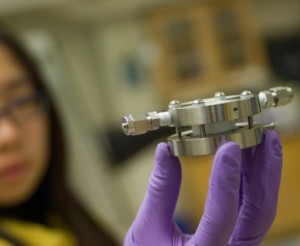 Better battery life is on the top of most people’s gadget wish lists. Now, a technology breakthrough from MIT offers hope for the mobile masses — but it will have to contend with other experimental approaches in a race to the market that could take years, experts say.
Better battery life is on the top of most people’s gadget wish lists. Now, a technology breakthrough from MIT offers hope for the mobile masses — but it will have to contend with other experimental approaches in a race to the market that could take years, experts say.
MIT researchers say they have found a way to create batteries that can offer up to three times the energy density of current batteries, while being much lighter. That paves the way for portable devices that could both be lighter and have a much longer battery life than current gadgets.
“You can get laptop battery life in a laptop computer similar that’s three times more than what you have now, even as the battery gets three times lighter, ” Yang Shao-Horn, associate professor of mechanical engineering and materials science at MIT, told batteries-company.com.
While advances in material sciences and chip design have led to more powerful computers with better displays, battery life has remained a big roadblock. That’s why new battery technologies have become a major area of research. Companies such as GE and IBM are exploring the promise of a new kind of battery called lithium-air. These batteries could replace existing lithium-ion batteries.
Lithium-air batteries have a lithium anode that is electrochemically coupled to atmospheric oxygen through an air cathode. By contrast, current lithium-ion batteries have a carbon anode and a metal oxide-based cathode.
“There’s huge potential for lithium-air batteries,” says Vishal Sapru, industry manager for power and energy system at research firm Frost & Sullivan. “The combination of lithium anode and air cathode not only makes them lighter than lithium-ion but also offers higher energy density.”
Sapru estimates that a typical lithium-air battery can offer an output of 1800 watts per kilogram compared to about 120 to 350 watts per kilogram seen in lithium-ion APPLE A1078 Battery.
But so far, there has been a lack of understanding about the kinds of electrode materials that could promote the electrochemical reactions that take place in lithium-air batteries, which has held back their development, says MIT’s Shao-Horn.
The answer, she says, according to her team, lies in using gold or platinum as a catalyst.
And despite the bling factor, batteries using these precious metals could still be cost competitive, says Shao-Horn. “We need to have only the surfaces covered by these elements,” she says. “We are not using platinum and gold in the bulk of the HP 395794-001 Battery.”
It’s an interesting breakthrough, agrees Sapru, but one that’s by no means guaranteed a commercial future. Other battery researchers are working on other materials, such as aluminum-polymer laminates, for instance. What will eventually reach the hands of consumers remains to be seen, he says.
“Till these technologies reach commercial manufacturing stage we can’t reliably tell how they will do in terms of costs and accessibility,” says Sapru. “While gold and platinum offer some advantages, aluminum-polymer laminates can be more flexible, so we will have to wait and see.”
Shao-Horn says her team’s ideas are still a long way from commercialization. The group is yet to perfect the chemistry of the charging and discharging processes and increase efficiency of the system, she says.
“Ultimately, just like we have different types of lithium-ion batteries today,” says Sapru, “we will have different lithium-air batteries. But all of this is a couple of years away from reaching consumers.”
Tagcloud: Battery Breakthrough, power laptop battery, laptop batteries, battery care tips, Sony VGP-BPS2C Battery,



9 thoughts on “Laptop Battery Breakthrough Promises Lighter Weight, More Power”
Comments are closed.